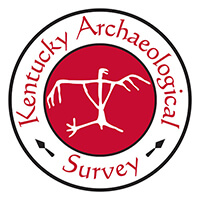First Farmers
On view September 9, 2022 through July 2025
This exhibition highlights diverse aspects of Native American farm life in the Barren River valley before European contact. Utilizing results of recent excavations by the Kentucky Archaeological Survey, First Farmers displays and interprets findings related to technology, settlement, foodways, society/politics, and economics/trade that reveal life in a farming village circa 1350 CE.
Click here to view the Virtual Exhibit Tour

Frequently Asked Questions
Around 900 CE, Indigenous people in western and south-central Kentucky developed an agricultural way of life centered on intensive crop production. They lived in villages, hamlets, and farmsteads along the Green River and its tributaries. These communities were linked to larger town-and-mound centers where political and religious authority was held by the chief, war leaders, and shamans.
These people were connected by the centralized political and religious authority of the chief as well as extensive trade networks. Raw materials and finished products moved through these networks across wide areas. Symbols and ceramic styles show that they shared rituals and religious beliefs. Because of the similarities in lifeways across the Southeastern US, archaeologists refer to all these peoples as Mississippians.
By the mid-to-late 1300s CE, when Holt site residents established their village along the Green River, Mississippian culture had existed for 400 years.
Western Kentucky University archaeologists recorded the Holt site during an archaeological survey of the Gasper River flooplain in 1972. Later, WKU student Bob Zoellner, under the direction of professor Dr. Jack Schock, excavated a small trench where landowner and WKU alum Dennis Holt had found a pottery concentration. Their work showed that ancient Indigenous farmers lived at the Holt site sometime after 1000 CE.
In 2019, archaeologists from Corn Island Archaeology, LLC returned to the Holt site. A bridge replacement project was planned nearby. Their work showed that part of the Holt site was in the road right-of-way But most importantly, it showed that the site held important information about Indigenous farmers.
Kentucky Archaeological Survey archaeologists worked at the Holt site in 2019 and 2020 before bridge construction began. In 2021, as part of WKU's Summer Archaeological Field School, students carried out more work at the site.
The Holt site demonstrates that Indigenous peoples lived in permanent settlements in what is now Kentucky. Archaeological work has demonstrated that our Commonwealth, long thought of as merely a "hunting ground," was the permanent home for Indigenous peoples for thousands of years before Europeans arrived in the Americas.
Ongoing excavations at the Holt site have revealed its connections to other sites in the region, both socially and politically. Notably, ceramic similarities demonstrated that Holt site residents had more in common with people living at Jewell on the Barren River - 36 miles away - than with their neighbors at Annis, which is only 12 miles north on the Green River.
Around 1400 CE, Indigenous Native peoples abandoned their towns and villages in the Barren River drainage. It is unclear whether these groups left the region or simply moved to small, dispersed settlements.
Some of the links on this page may require additional software to view.


